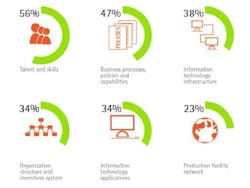I hate to say a term is overused, unless, of course, it’s a term commonly associated with corporate BS bingo games, such as “synergy”, “win-win”, or “paradigm shift”. After seeing the results of Accenture’s most recent survey of 250 global manufacturers, however, I’m beginning to wonder if the term “flexibility” may soon be keeping company with the likes of “ecosystem”.
Despite the economic optimism expressed by 85 percent of respondents to Accenture’s 2013 Global Manufacturing Study (“How Leading Manufacturers Thrive in a World of Ongoing Volatility and Uncertainty”), the vast majority of global manufacturers believe they “lack the ability to swiftly respond to marketplace uncertainty and volatility.” This is a key disconnect, because the respondents’ optimism is rooted in their expectation that the economies of their top markets will continue to grow through 2014. And more often than not, growing demand coincides with changing demands.
The Accenture study notes that “82 percent of the 250 global manufacturers participating in the study, agree that their ability to dynamically move production from one facility to another or to change their product mix at a plant will be critical to growing their business. However, only 27 percent believe any component of their operating model is very effective at accommodating a shift in resources and activities to alternate locations. Additionally, only 24 percent of those surveyed think their company is highly adept at sensing market changes or opportunities before their competitors.”
Looking on the bright side of this assessment, 72 percent of respondents say they plan to improve their operating model in the next year. The investments now being made for such improvements are being allocated “across operating model components, ranging from talent, business processes, policies and capabilities; to the information technology infrastructure, organizational structure and production facility networks to drive flexibility into their operations,” said Russ Rasmus, global managing director of the Accenture Manufacturing practice.
One key operating model decision that will prove to be the focus of new investments, according to the Accenture survey, involves “the balance of investment between new and existing plant assets.” Sixty-six percent of responding manufacturers are focusing on extending the life and contributions of existing assets. To achieve this, 67 percent will apply lean principles; 49 percent will apply total productive maintenance; 48 percent will apply automation and technology; and 21 percent will apply analytics.
The survey also notes that manufacturers are investing in and integrating digital capabilities into their operations, with 77 percent planning to invest in information technology. Topping their list of IT priorities is performance management (53 percent), which includes “the development of dashboards and metrics that can help management monitor performance and provide early warning of changes in the business and operations environment.”
“Manufacturers are making information technology investments a higher priority as they focus on automation and driving a digital strategy across their enterprises,” said Rasmus. “In tandem, manufacturers will have to put in place the right talent and skills as part of the effort to maximize the return on these investments.”
To read the full report visit: www.accenture.com/manufacturingresearch
About the Author
David Greenfield, editor in chief
Editor in Chief

Leaders relevant to this article:
